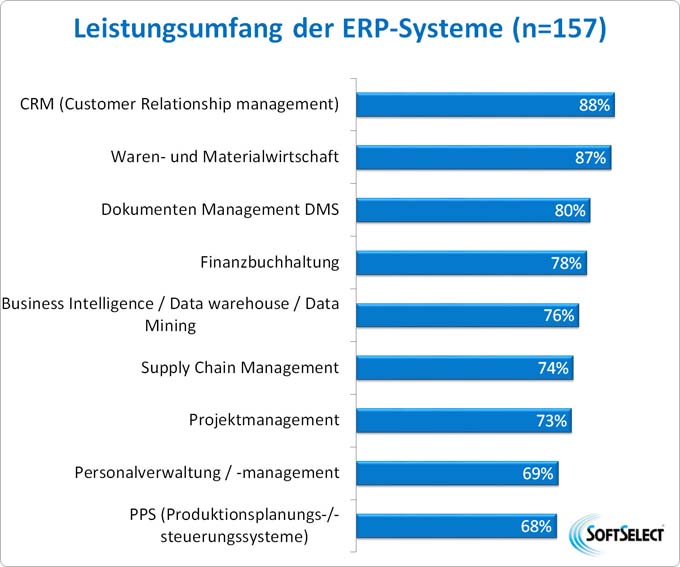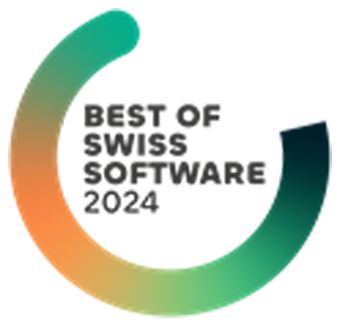Study on ERP software trends 2021 reveals new market developments
The Hamburg-based market research and consulting firm SoftSelect has examined a total of 157 ERP solutions as part of its ERP Software Trends 2021 study and reveals current market and development trends relating to ERP systems. It shows that ERP systems are at the center of data clouds.

Data worlds from the cloud are constantly expanding. Technology stacks in the supply chains are increasingly interconnected. For this reason, the software applications in companies - first and foremost the ERP system as the digital image of the process organization and control instrument of the entrepreneurial value creation - have the complex task of taking over the integration of these data worlds into the business management heart of the company and making them usable in the sense of the company's goals. Trends such as big data analytics and artificial intelligence (AI), mobility, microservices, and the merging of production and IT are also fueling the digital transformation and facilitating the establishment of new, increasingly digitally supported business models. All this is the subject of SoftSelect's study on ERP software trends 2021.
Easing of investment brakes
After the Covid-19 restrictions on the entire social life over the past 12-18 months, many companies are now looking forward again and in many places the course has already been set for growth again, according to a finding of the study. It is also apparent that the reluctance to invest in digital infrastructure that is still often observed is increasingly giving way to a willingness to implement IT projects quickly. In many places, the aim is to eliminate any digitalization deficits.
The ERP system in particular, as the central process and data hub in the company, comes into focus when processes and entire business models are put to the test. By being able to link transactional, behavioral or, for example, technical IoT data with the commercial and master data from the ERP, companies not only achieve an improvement in data quality in the information network, but also create an important foundation for the control and automation of workflows beyond the ERP core.
ERP Software Trends 2021: Diversity of Offerings Grows
A few more concrete findings from the ERP Software Trends 2021 study: On the ERP vendor side, the service offering is not only showing growth in breadth (e.g., new cloud offerings, apps, business analytics, platform connectors, etc.), but also in depth. The most common core areas of ERP solutions include CRM (88 percent coverage), inventory and materials management (87 percent coverage) and document management (80 percent). While around three quarters of ERP solutions provide modules for financial accounting (78 percent), analytics components such as business intelligence, data warehousing or data mining (76 percent), supply chain management (74 percent) or project management (73 percent), around two out of three providers cover the areas of human resources/personnel management (69 percent), production planning/control (PPC for short, 68 percent), e-commerce (68 percent) or customer service (68 percent). The areas of payroll accounting (55 percent) and machine data acquisition (48 percent) are still covered by every second solution.

Many ERP solutions are also focused on specific industry segments such as industry (75 percent), retail (67 percent) or services (63 percent). In the industrial application environment, a wide range of manufacturing types are supported - from make-to-order production (98 percent coverage), small batch production (94 percent) and variant production (90 percent) to lot-size production (90 percent) and repetitive manufacturing (87 percent) to flow production (68 percent), kanban production (64 percent) and process manufacturing (60 percent). According to vendor data, 70 percent of ERP systems can be used regardless of industry. However, the range of ERP solutions thins out considerably for specific industry sectors such as transport and logistics (43 percent), skilled trades (42 percent), construction (34 percent) or the public sector (27 percent).
Java environments continue to gain ground
Not only is the range of ERP solutions more diverse than ever before due to new cloud, mobile and industry solutions, but the question of the optimal technology and the individually suitable deployment model also preoccupies user companies facing investment decisions today. 90 percent of the ERP systems examined in the study are classically offered as in-house variants. In contrast, 72 percent of the solution offerings are provided via the cloud. The offering is still dominated by client-server (88 percent), multi-tier (72 percent) and partially web-based architectures (67 percent). However, purely web-based applications are still the exception (12 percent), at least in the ERP area. The majority of ERP systems use .NET as their technological platform (60 percent), while Java accounts for a share of around 54 percent - an increase of 12 percentage points compared with 2020. The principles of service-oriented architectures (SOA) are implemented by around 49 percent of ERP solutions.
Multi-cloud sourcing
The approach of a hybrid IT landscape, in which certain core processes are operated "on-premise" or in the company's own cloud and are extended as required by applications from the public cloud, is becoming increasingly popular. Although private clouds are used for privacy-critical processes and sensitive data (e.g., customer or HR master data), public clouds are often used for non-critical data, e.g., from test or IoT environments. By storing part of the content locally and another part in the cloud and synchronizing it, companies want to retain control over critical data (keyword: data sovereignty), but at the same time offer users and partners more flexibility in access. The choice of the future data deployment model is now a central question that has a major influence on the future IT strategy and the choice of ERP service provider. After all, no company today wants to close itself off to future developments for years (with ever shorter innovation cycles) by locking into a particular technology or provider. Today, HR functions, CRM services, collaboration tools and databases are increasingly being provided from the cloud. In addition to public cloud and private cloud operation, the integration of several data clouds in a so-called multi-cloud is gaining in importance. In order to make data from external clouds usable for the benefit of the company's own value creation or for controlling processes, various data clouds, cloud applications, systems of collaboration partners or IoT environments are brought together in a cloud stack via a multi-cloud and managed centrally.
"The ERP system does not need to fear for its standing as the leading system within the IT landscape for years to come. Although external clouds are increasingly taking on the function of an additional data hub, the ERP system acts as an integration and control platform for all core business processes and maps the process knowledge across the entire value chain," says SoftSelect Managing Director Michael Gottwald, summarizing the study results.
Source and further information: http://www.softselect.de/erp-studien









